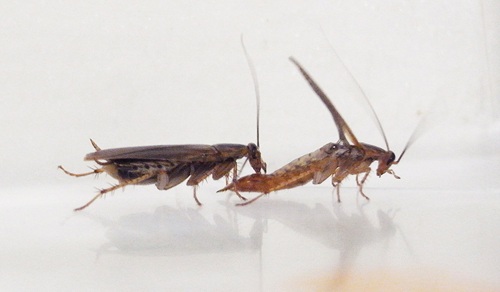Cockroaches are among the most common pests found in Indian households. They are not only unpleasant to see but also carriers of germs and diseases. While most people see cockroaches simply as pests, entomologists (insect experts) and even pest-control professionals often need to identify whether a cockroach is male or female. Interestingly, there are clear differences between the two if you know what to look for.
In this article, we will explore the physical and behavioral traits that help in identifying male and female cockroaches.

Size and Body Shape
One of the easiest ways to differentiate between male and female cockroaches is by their body size:
- Male Cockroach: Generally smaller, slimmer, and lighter in body weight. Their abdomen looks narrower and more pointed.
- Female Cockroach: Larger, heavier, and broader in shape. Their abdomen is rounder and more expanded.
👉 In simple words, female cockroaches usually look bulkier compared to males.
Wings
The wings of male and female cockroaches are different in most species:
- Male Cockroach: The wings are longer than the body, covering the abdomen completely and sometimes extending beyond it. This makes males more agile and better fliers.
- Female Cockroach: The wings are shorter or equal to the body length and may not completely cover the abdomen. Females rarely fly, and in some species, their wings are underdeveloped.
Antennae and Movement
- Males have relatively longer and thinner antennae, which they use to detect pheromones from females. They are more active and move faster.
- Females have slightly shorter antennae and appear less restless compared to males.
Abdomen Segments
Looking closely at the underside of the cockroach’s abdomen also reveals differences:
- Male Cockroach: The last two segments of the abdomen are visible and pointed.
- Female Cockroach: The last segments are usually hidden by the broader abdomen, making them less visible.
Cerci and Styli (Tail-like Structures)
At the end of the abdomen, cockroaches have small sensory appendages called cerci, and in males, an extra structure called styli is present.
- Male Cockroach: Has cerci (pair of long projections) and also styli (shorter, bristle-like structures) on either side of the last abdominal segment.
- Female Cockroach: Has only cerci, but no styli.
👉 This is one of the most reliable biological identifiers of sex in cockroaches.
Reproductive Features
- Female Cockroach: Produces an ootheca (egg case), which she carries or deposits in safe places. If you notice a cockroach with a capsule-like case attached near its abdomen, it is definitely a female.
- Male Cockroach: Does not produce ootheca. Their role is mainly to fertilize the female.
Behavioral Difference
- Males are more adventurous and often roam around in search of food or mates. They are the ones commonly spotted flying around lights.
- Females are more secretive and prefer hiding in dark corners to protect themselves and their eggs.
Why Identifying Male and Female Cockroaches Matters
- Pest Control: Female cockroaches lay dozens of eggs, leading to infestations. Identifying them helps in targeting the source of population growth.
- Scientific Study: In labs, researchers study male vs. female cockroach behavior for pest management.
- Awareness: For homeowners, knowing the difference explains why cockroaches multiply quickly—because a single female can produce hundreds of offspring.
Conclusion
Identifying male and female cockroaches is not very difficult once you know the signs. Males are smaller, slimmer, with longer wings and styli, while females are larger, broader, with shorter wings and no styli. Females also carry egg cases (ootheca), which makes them easier to identify.
By understanding these differences, one can better monitor infestations at home and take timely pest control measures. After all, the female cockroach is the real culprit behind rapid population growth, and knowing how to spot her can make pest control more effective.